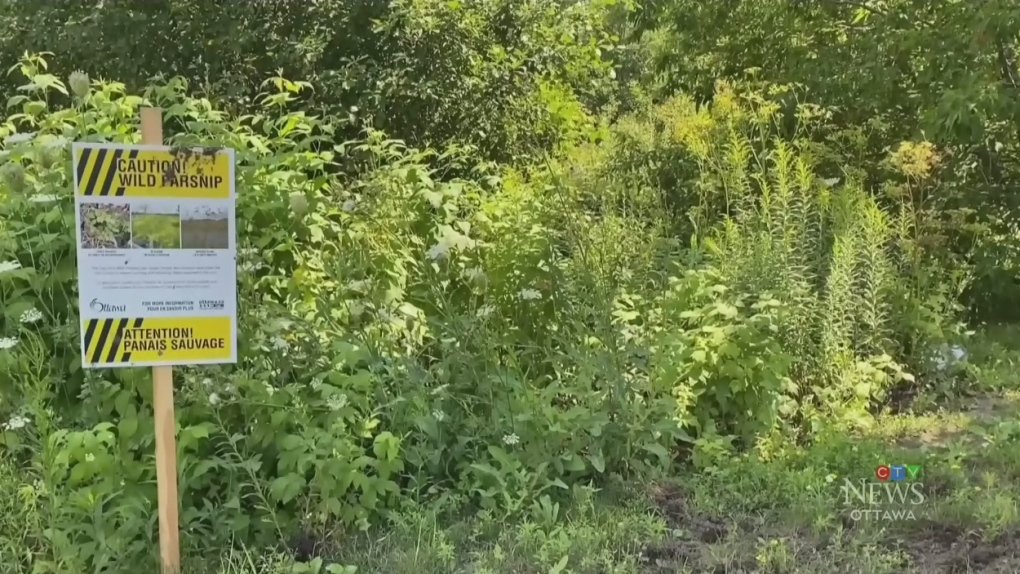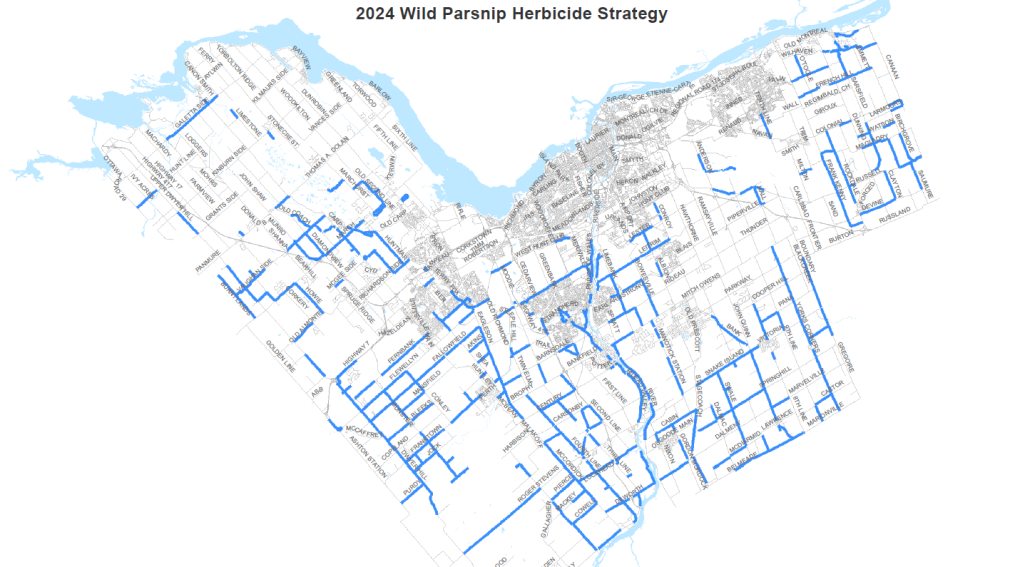Ottawa to begin spraying and mowing wild parsnip next week

The City of Ottawa will spend $298,000 this year to deal with wild parsnip in parks and along roadsides and pathways across the city.
Starting next week, the city will begin spraying and mowing areas along 1,200 kilometres of roadsides and pathways and at more than 200 park locations to reduce the growth of wild parsnip in highly infested areas.
Wild parsnip is an invasive plant that can cause skin and eye irritation and make the skin prone to burning and blistering.
"We heard from residents and Councillors that additional treatment was required and have significantly increased the number of lane kilometres to be treated this year within existing budgets," Alain Gonthier, general manager of Public Works, said in a memo to council.
"Public Works will continue to assess the required resources and budget for spraying operations in future years. Roadside grass cutting will begin early June, and additional herbicide application may be considered again for the fall season."
The city is expanding treatment for wild parsnip from 650 kilometres in 2023 to 1,200 kilometres of roadsides and pathways this year.
Staff will begin treating roadsides the week of May 27, with wild parsnip spraying in parks to begin on June 3, weather permitting.
The 2024 strategy will see the city continue and expand the application of Clearview and Navius FLEX herbicides in highly infected areas.
Rural property owners can ask the city not to spray the areas adjacent to their property.
Wild parsnip has been identified as a noxious weed in Ontario since 2015.
 The City of Ottawa released a map showing where it will spray and mow for wild parsnip in 2024. (City of Ottawa/release)
The City of Ottawa released a map showing where it will spray and mow for wild parsnip in 2024. (City of Ottawa/release)
- Sign up now for daily CTV News Ottawa newsletters
- The information you need to know, sent directly to you: Download the CTV News App
What is wild parsnip?
Wild parsnip is a highly branched plant, with hollow green stems, according to the city of Ottawa's website.
"It has two growth stages: non-flowering leafy rosettes at ground level and 0.5 to 1.5 metre-tall flowering plants."
Here are the stages of growth:
Early growth: In the first year of growth, low-growing non-flowering rosettes of leaves form with a cluster of spindly, compound leaves that resemble celery leaves.
In bloom: When wild parsnip is in bloom, usually in the second and third-year plants have tall, branched yellow flowering stalks that usually bloom in early June to late July.
Mature plant: Starting in August the blooming plant will begin to turn brown and the leaves and stems will begin to dry up. This means that the toxic sap from the plant will also begin to dry up, and contact with the plant is less likely to cause a reaction.
Avoiding wild parsnip
The city of Ottawa offers the following tips to avoid wild parsnip on pathways and in parks:
- Stay on the groomed areas of parks, roadsides and pathways where there are less instances of wild parsnip.
- When working around wild parsnip or when walking through dense vegetation, wear goggles, gloves, long pants and long-sleeved shirts.
- Children should be reminded not to pick wild flowers
- If you are exposed to the plant sap, wash the contaminated area(s) thoroughly as soon as possible, and seek medical attention if skin irritation occurs
CTVNews.ca Top Stories

Trump threatens to try to take back the Panama Canal. Panama's president balks at the suggestion
Donald Trump suggested Sunday that his new administration could try to regain control of the Panama Canal that the United States “foolishly” ceded to its Central American ally, contending that shippers are charged “ridiculous” fees to pass through the vital transportation channel linking the Atlantic and Pacific Oceans.
Man handed 5th distracted driving charge for using cell phone on Hwy. 417 in Ottawa
An Ottawa driver was charged for using a cell phone behind the wheel on Sunday, the fifth time he has faced distracted driving charges.
Wrongfully convicted N.B. man has mixed feelings since exoneration
Robert Mailman, 76, was exonerated on Jan. 4 of a 1983 murder for which he and his friend Walter Gillespie served lengthy prison terms.
Can the Governor General do what Pierre Poilievre is asking? This expert says no
A historically difficult week for Prime Minister Justin Trudeau and his Liberal government ended with a renewed push from Conservative Leader Pierre Poilievre to topple this government – this time in the form a letter to the Governor General.
opinion Christmas movies for people who don't like Christmas movies
The holidays can bring up a whole gamut of emotions, not just love and goodwill. So CTV film critic Richard Crouse offers up a list of Christmas movies for people who might not enjoy traditional Christmas movies.
More than 7,000 Jeep SUVs recalled in Canada over camera display concern
A software issue potentially affecting the rearview camera display in select Jeep Wagoneer and Grand Cherokee models has prompted a recall of more than 7,000 vehicles.
'I'm still thinking pinch me': lost puppy reunited with family after five years
After almost five years of searching and never giving up hope, the Tuffin family received the best Christmas gift they could have hoped for: being reunited with their long-lost puppy.
10 hospitalized after carbon monoxide poisoning in Ottawa's east end
The Ottawa Police Service says ten people were taken to hospital, with one of them in life-threatening condition, after being exposed to carbon monoxide in the neighbourhood of Vanier on Sunday morning.
New York City police apprehend suspect in the death of a woman found on fire in a subway car
New York City police announced Sunday they have in custody a “person of interest” in the early morning death of a woman who they believe may have fallen asleep on a stationary subway train before being intentionally lit on fire by a man she didn't know.


































